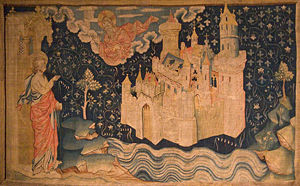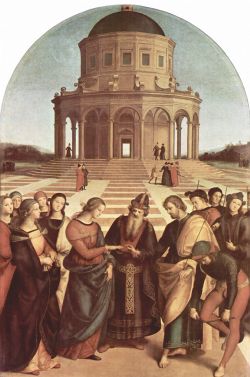Bride of Christ
The Mystical Marriage of St. Catherine
Antonio Boselli (Italy fl. 1496-1536)The term Bride of Christ can be found in Torah, the Old Testament and in the New Testament. It has long been debated and interpreted withinJudeo-Christian circles as both a literal and metaphorical reference. Literally, the most common expression is to be found in believers who report a "mystical union" with Jesus Christ. The idea of a literal, physical bride of Jesus on earth during the period of his ministry (or Incarantion)is however, considered an unthinkable heresy within most all Christendom. However, the suggestion of such an idea has persisted and has recently been revived, particularly, through contemporary interpretations of the legend of the Holy Grail.
Metaphorically, the Bride of Christ is a term most often representing the body of believers of the Christian Church or the Ecclesia.[1] The reference originates from the Old Testament prophets who described Israel as God's bride.[2]
In the Roman Catholic Church, this image of the Church as Christ's bride has been connected or associated with nuns and consecrated virgins.[3] For some women, the image describes a more personal, mystical relationship with Jesus. Several examples include Anne Catherine Emmerich, Joanna Southcott, Gertrude Morgan, Åsa Waldau, Catherine of Alexandria, Catherine of Siena, and Catherine de' Ricci.
The Church as the Bride
The imagery and symbolism of the bride has often been applied to the body of believers known as The Church. In the New Testament, Jesus Christ is referred to as the bridegroom, sacrificing and, ultimately, dying for his chosen bride. [4] Traditionally, just as there is a betrothal period during which bride and groom are separated until the wedding, so is the bride of Christ separated from her bridegroom until the time of the wedding. Her responsibility during the betrothal period is seen as "being faithful" to him. [5] In further prophesy, it is said that at the time of the Second Coming of Christ, the bride (or Church) will be united with the Bridegroom and the official "wedding ceremony" will take place, resulting in the eternal union of Christ and his bride at last. [6]
Also, the bride (or Church) will finally inhabit the heavenly city known as New Jerusalem or “the holy city”. [7] In his vision or revelation, the Apostle John sees the city and its inhabitants coming down from heaven, wearing white garments and/or adorned “as a bride.”
Mystical Marriage
In Christianity, virginity has been considered from the earliest centuries as a special offering made by the soul to its spouse, Jesus Christ. However, the contradiction remained within the priesthood that marriage was allowed and encouraged for most of early church history. Various notions have afterwards developed, some more completely, and the phrase mystical marriage has come to be viewed in two basic senses; one wide, one more restricted. According to Roman Catholicism, "in many of the lives of the saints, the wide sense is intended. Here the mystical marriage consists in a vision in which Christ tells a soul that He takes it for His bride."[8]
Catherine of Sienna, in the final years of her life, purportedly "besought her Divine Bridegroom to let her bear the punishment for all the sins of the world" after a life filled with the "wonderful spiritual fellowship of disciples round her, both men and women united to her by the bonds of mystical love."[9] St. Catherine of Alexandria, a "virgin and martyr" of the Roman Catholic Church, by some accounts also experienced such mystical bonds, even marriage to Christ himself. However, today, The Catholic Church takes a fairly cautious approach, making little or no "official" mention of such accounts.[10] St. Catherine de' Ricci (1522-1590), born, Alessandra Lucrezia Romola, as a Dominican nun came to be known for her highly mystical life, especially for her ecstasies of the Passion (or crucifixion) of Christ at a consistent time for 12 years. While in trance she would exhort those about her with "an eloquence beyond her native talent" and on her own body would be seen the stigmata (the wounds) of Christ's passion. Further, she was given in "mystical marriage" to Christ in 1542, evidenced by a "ring" that some reportedly saw on her index finger in some form or another - or not at all.[11]
Notes
- ↑ Ephesians 5:22-23
- ↑ Isaiah 54:9. Bible, see also Hosea, Ezekiel and the Song of Solomon.
- ↑ Consecrated virgins and widows. Catechism of the Catholic Church.
- ↑ Ephesians 5:25-27
- ↑ 2 Corinthians 11:2
- ↑ Revelation 19:7-9
- ↑ Revelation 21:10
- ↑ Mystical Marriage
- ↑ Catholic Encyclopedia - St. Catherine of Siena
- ↑ "transformed and distorted by fantastic and diffuse descriptions . . ."
- ↑ St. Catherine de'Ricci
ReferencesISBN links support NWE through referral fees
- Hanson, Dr. Sharon. The Marriage of the Bride of Christ. Lulu Enterprises, UK Ltd (November 7, 2006). ISBN 978-1847287885.
- Inglis, Cecilia. Cecilia: Bride of Christ & Beyond. Penguin Global (February 15, 2004). ISBN 978-0143001294.
- Ingram, John. Beyond Da Vinci: The True Bride of Christ. AuthorHouse (July 20, 2006). ISBN 978-1425945091.
- Johnston, William. Mystical Theology: The Science of Love. Orbis Books (March 1998). ISBN 978-1570751752.
- Lawley, Martha. Attending the Bride of Christ. Lifeway Church Resources (2005). ISBN 978-1415820919.
External Links
- What does it mean that the church is the bride of Christ? GotQuestions.org.
- The Bride of Christ : a problematic wedding - Ephesians 5:22-33 Biblical Theology Bulletin, Spring, 2002 by Carolyn Osiek.
- The Bride of Christ: Is the Church really Christ's bride? SeekersTrove.com - Where the Bible is King.
- The Bride of Christ by Pastor Jim Feeney, Ph.D.
- Who Is The Bride of Christ? Chapter 14; by Eddie Chumney; Hebraic Heritage Ministries International.
- The Bride of Christ by Paul Carus; The Open Court Publishing Co. (1907).
- The Bride of Christ Grace Points.com.
- The Legend of Saint Catherine of Alexandria
- Catherine of Alexandria article on Orthodox Wiki.
- Saint Catherine of Siena
- St. Catherine de' Ricci
Credits
New World Encyclopedia writers and editors rewrote and completed the Wikipedia article in accordance with New World Encyclopedia standards. This article abides by terms of the Creative Commons CC-by-sa 3.0 License (CC-by-sa), which may be used and disseminated with proper attribution. Credit is due under the terms of this license that can reference both the New World Encyclopedia contributors and the selfless volunteer contributors of the Wikimedia Foundation. To cite this article click here for a list of acceptable citing formats.The history of earlier contributions by wikipedians is accessible to researchers here:
The history of this article since it was imported to New World Encyclopedia:
Note: Some restrictions may apply to use of individual images which are separately licensed.

